Big Bang
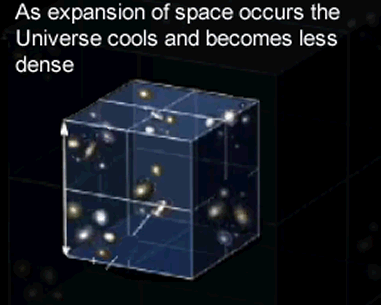
The cosmic microwave background, shown on the right, is uniform microwave glow that is in every direction in the sky. This is evidence of a beginning event (Big Bang). What causes the microwave glow?. Well, as light travels away from a source it is red shifted, or stretched. Light that has been traveling since the creation of electrons and atoms, some 300,000 years after the Big Bang has stretched to microwave size wavelengths by now.
We relate the Big Bang to an explosion. However the beginning event was not an explosion but a sudden unfolding, expansion you might say, of space and the Universe.
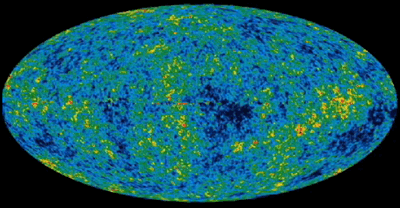
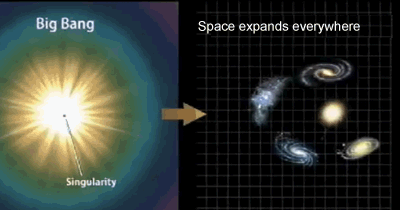

Listen to the audio on the right.
The universe is expanding. What can we conclude from this about our earliest Universe?
What is the Big Bang?
What is inflation?
How old is our Universe?
How long did it take for atoms to appear after the initial inflation period? Why did it take so long?
When the Universe cooled to 3,000K it became transparent. Why?
The Big Bang theory explains a great deal of what we observe in space, however, it does not explain the variations in density found in space and why opposite ends of the our Universe are so far apart that it takes light longer to travel to these points than the predicted age of the Universe. Something else is needed to explain these observations. Astronomers have subsequently proposed the existence of dark matter and dark energy. The fact that our Universe is undergoing accelerated expansion is most likely due to a repulsive force called dark energy.
It is also observed that the Universe is lacking some mass. 80% of the mass of the Universe can not be accounted for. Galaxies would pull themselves apart if they were composed of only the mass that is visible . Judging by the rotational speed they should be composed of more matter than is visible. Another form of matter must be present that does not reflect, absorb or produce light. We call this dark matter. The young Universe was almost smooth and featureless. As it expanded, it became organized. We know that our solar system is organized into planets orbiting around the Sun. Stars were collected into galaxies much like our own Sun is part of the Milky Way galaxy. The Milky Way contains about 100 billion stars. Further still, individual galaxies are concentrated into groups called clusters of galaxies.
Clusters include the galaxies and material, hot gas, which fill the space between the galaxies. This gas is so hot in the range of ten million degrees, that it shines in X-rays instead of visible light. On the right is an overlay of an optical image of a cluster of galaxies with an x-ray image of hot gas lying within the cluster. By studying the distribution and temperature of the hot gas we can measure how much it is being squeezed by the force of gravity from all the material in the cluster. This allows scientists to determine how much total material there is in that part of space.
It turns out that there is more mass in the cluster than is visible. More evidence for dark matter.
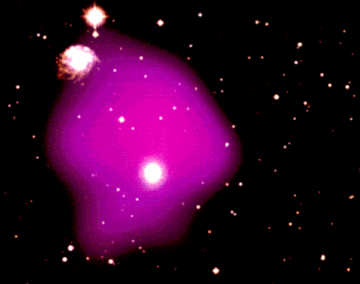
The Big Bang theory states that matter should spread evenly across space with uniform speed, trajectory and distribution. However something is causing galaxies to clump together as shown on the right and expand with varying speeds. Something is also causing the Universe to suddenly accelerate outwards. It is these anomalies that gave rise to the theory of the existence of dark matter and dark energy.
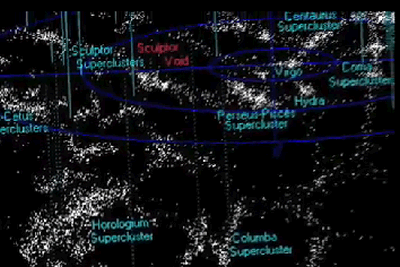
What observations gave rise to the Big Bang theory?
What observations can not be explained by the Big Bang theory?
Discuss the evidence for the existence of dark matter.Listen to a talk on dark energy and dark matter given by Leonard Susskind Professor of Theoretical Physics Stanford University July 2008
How does Professor Susskind describe dark matter?
Dark energy is described as being very strange. Why?